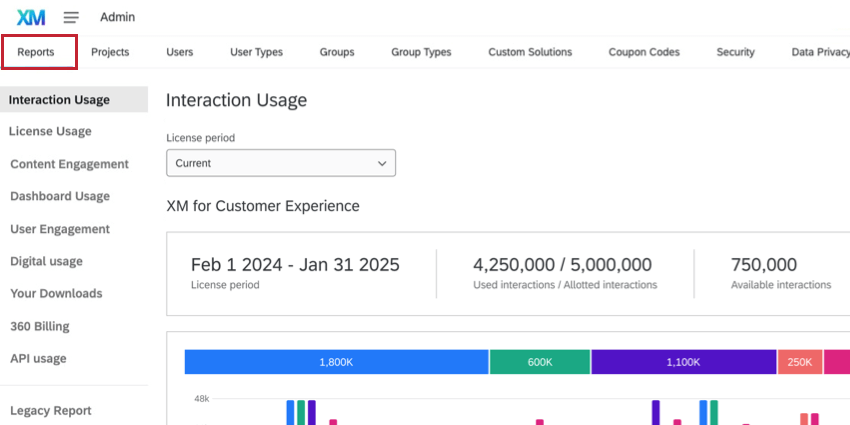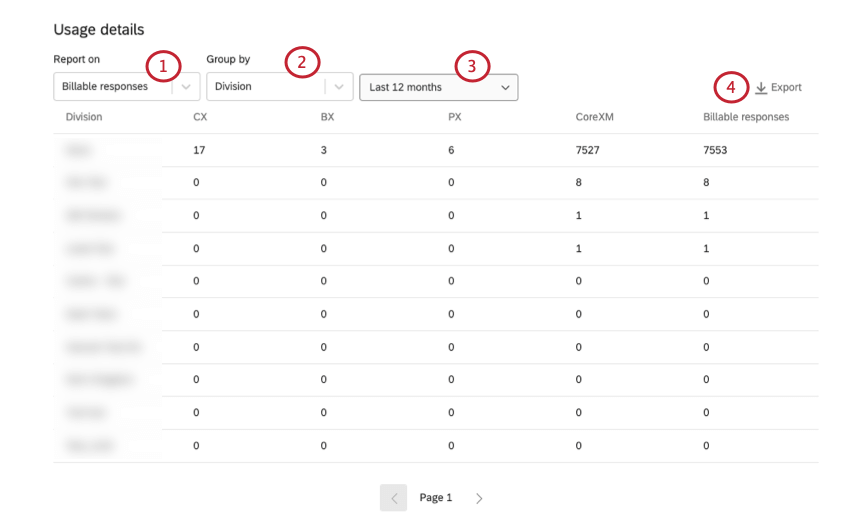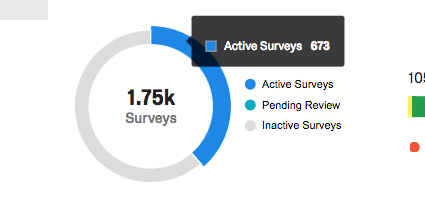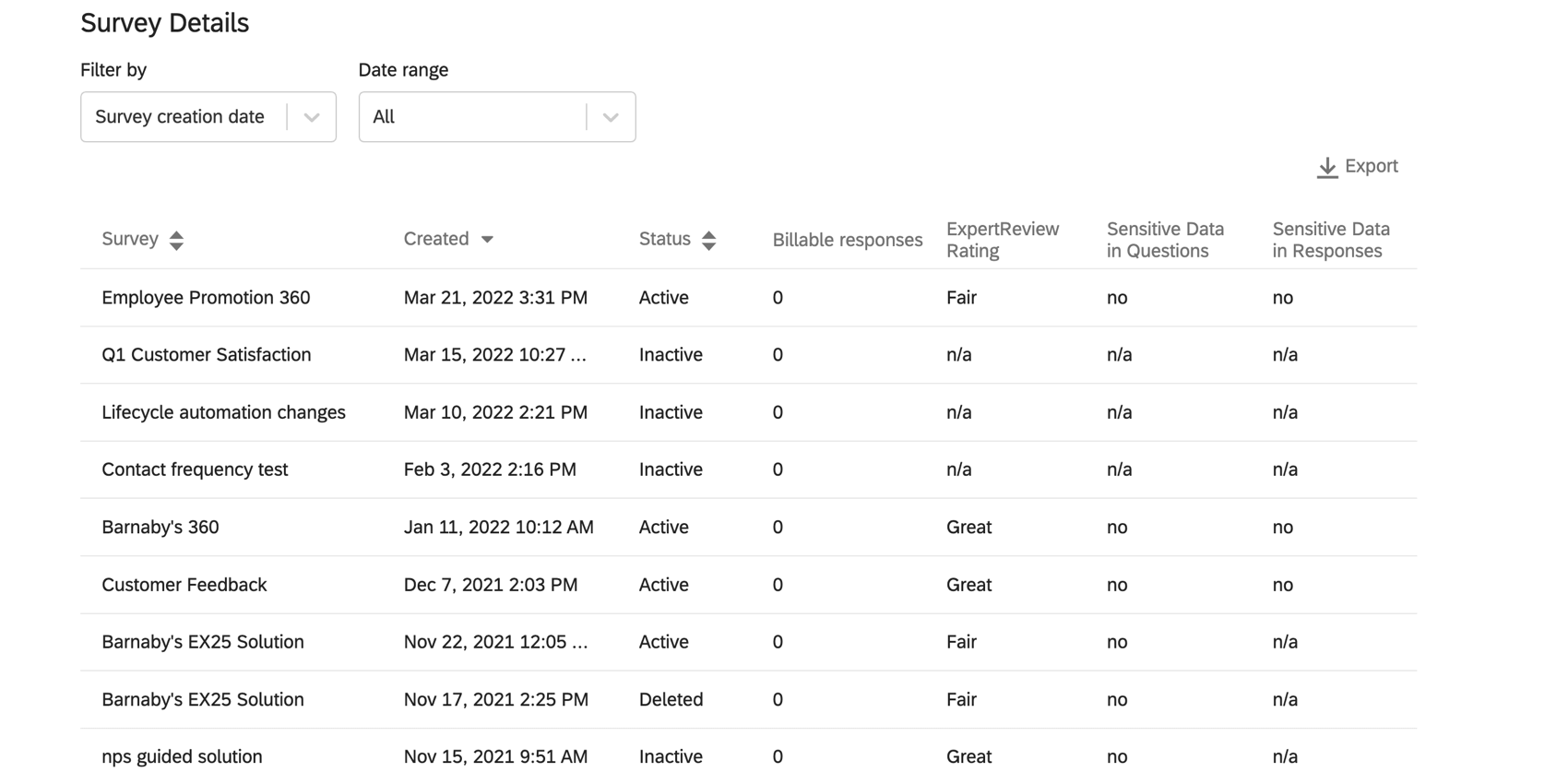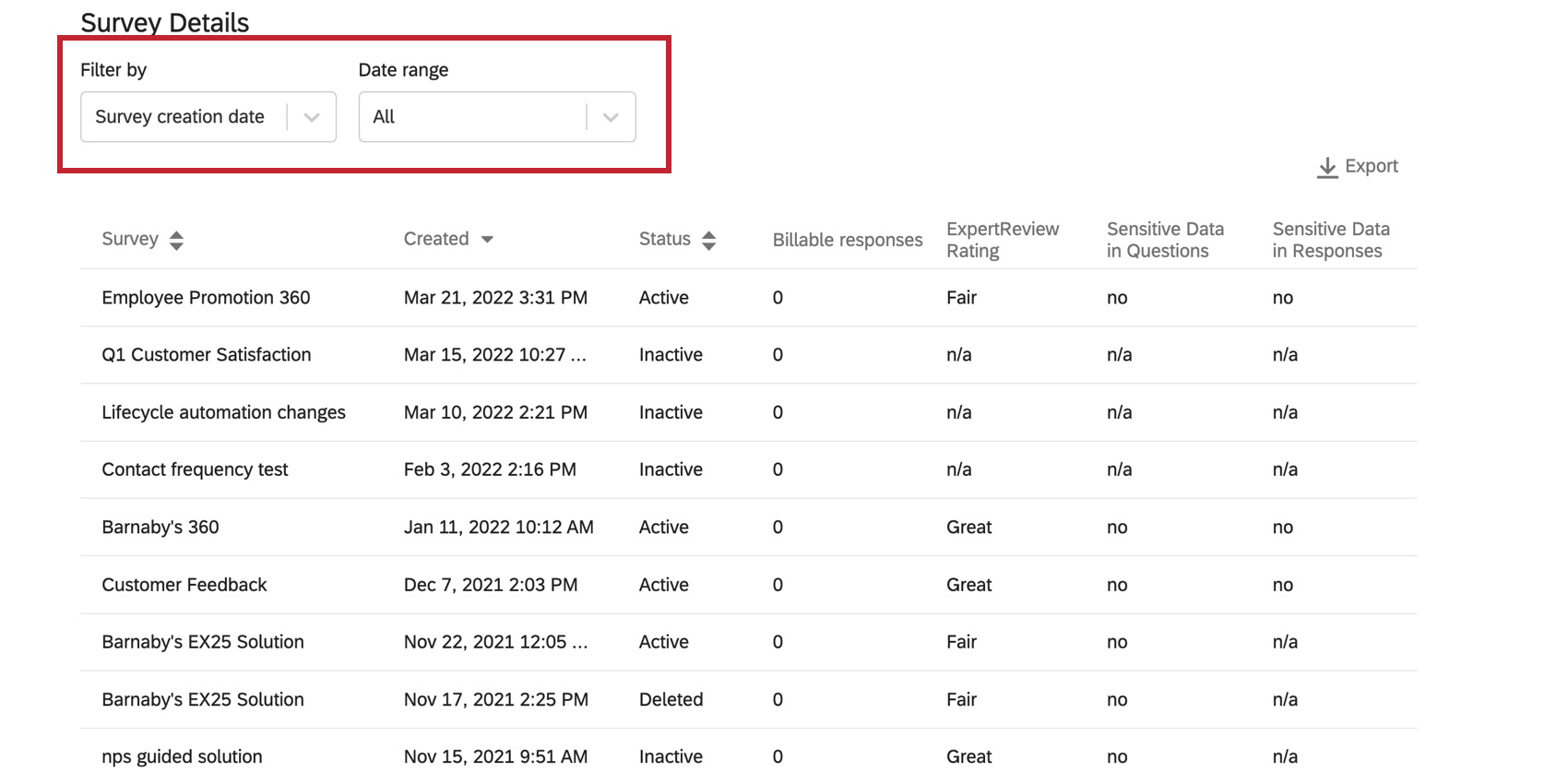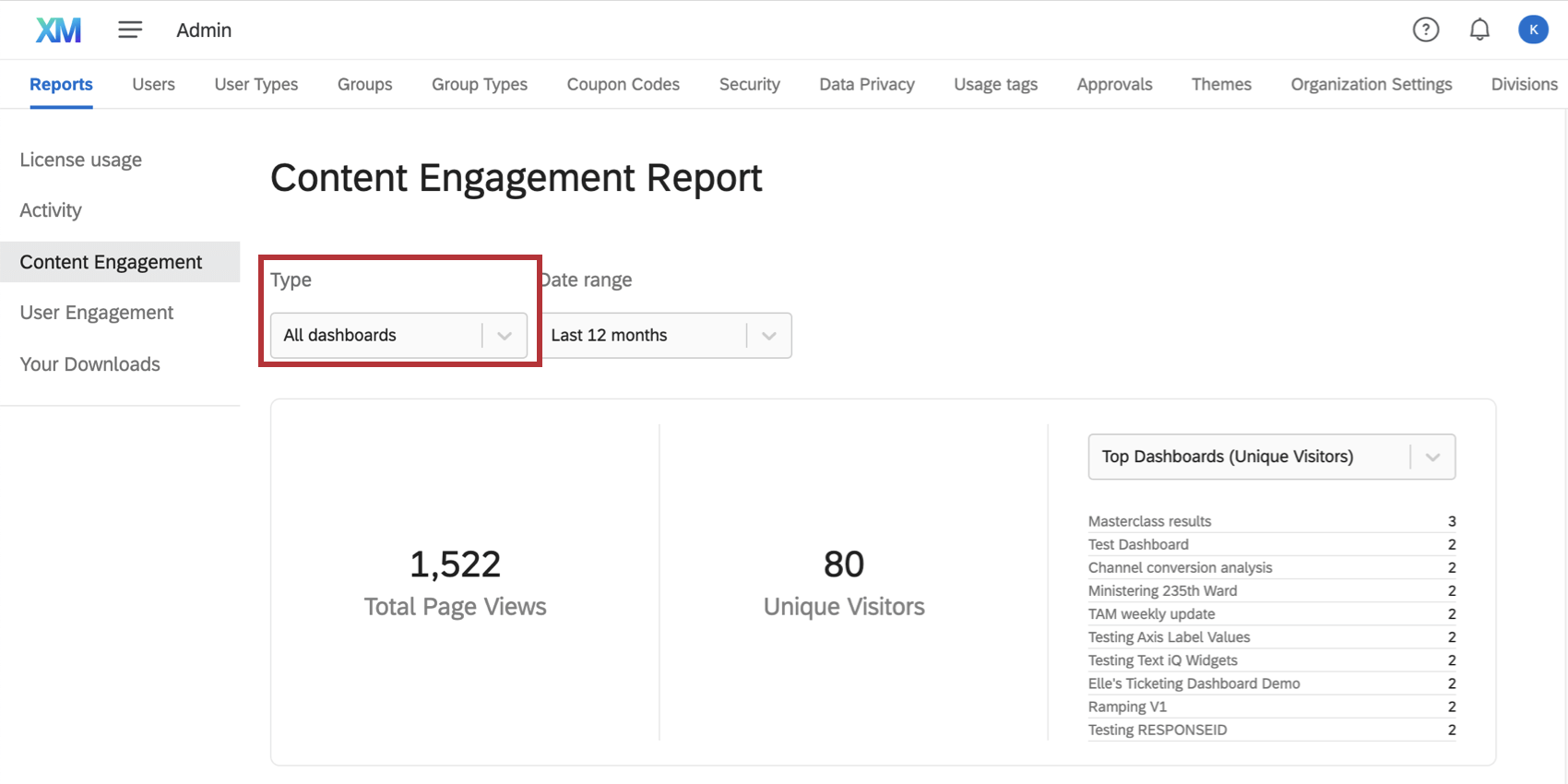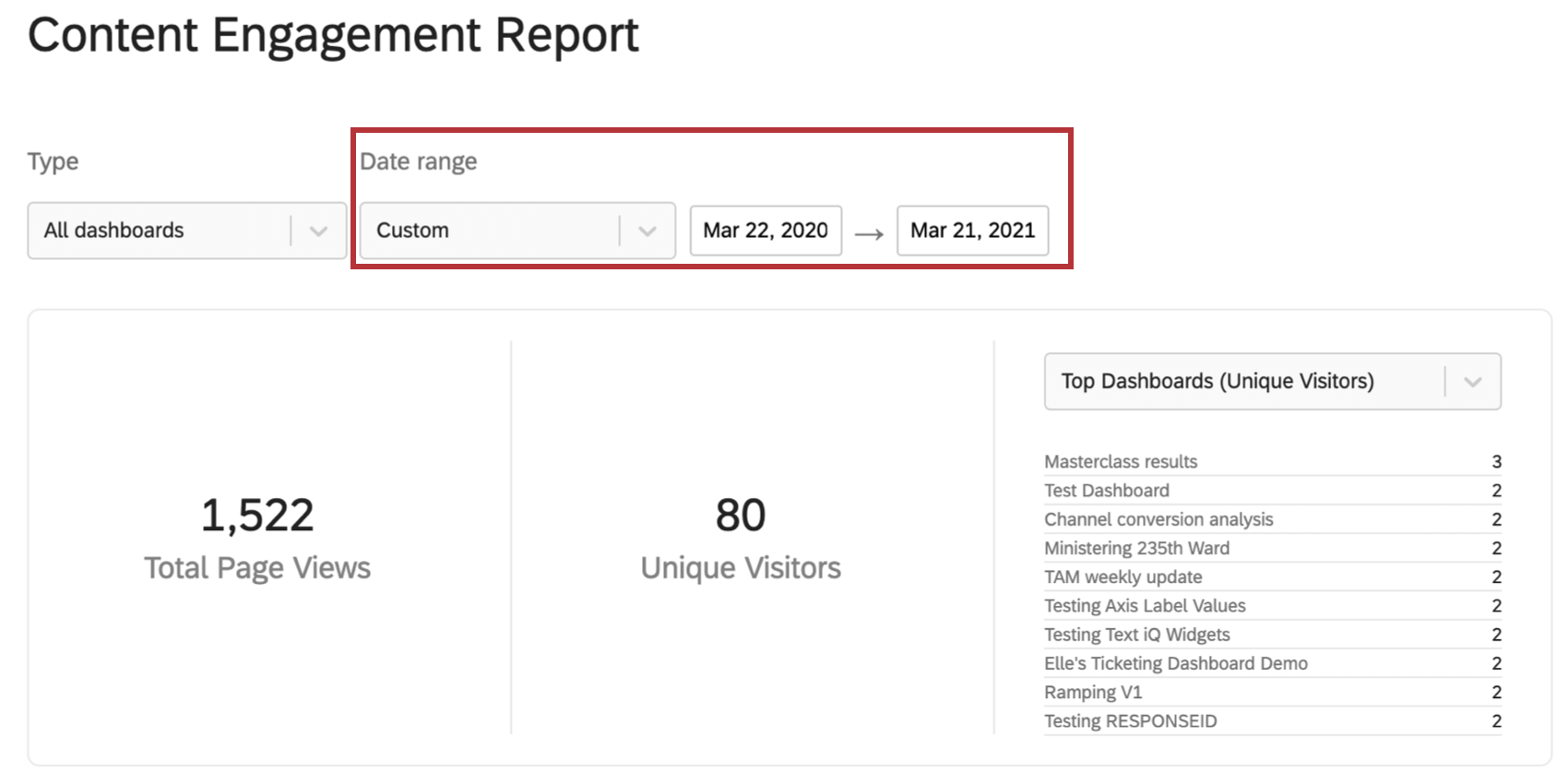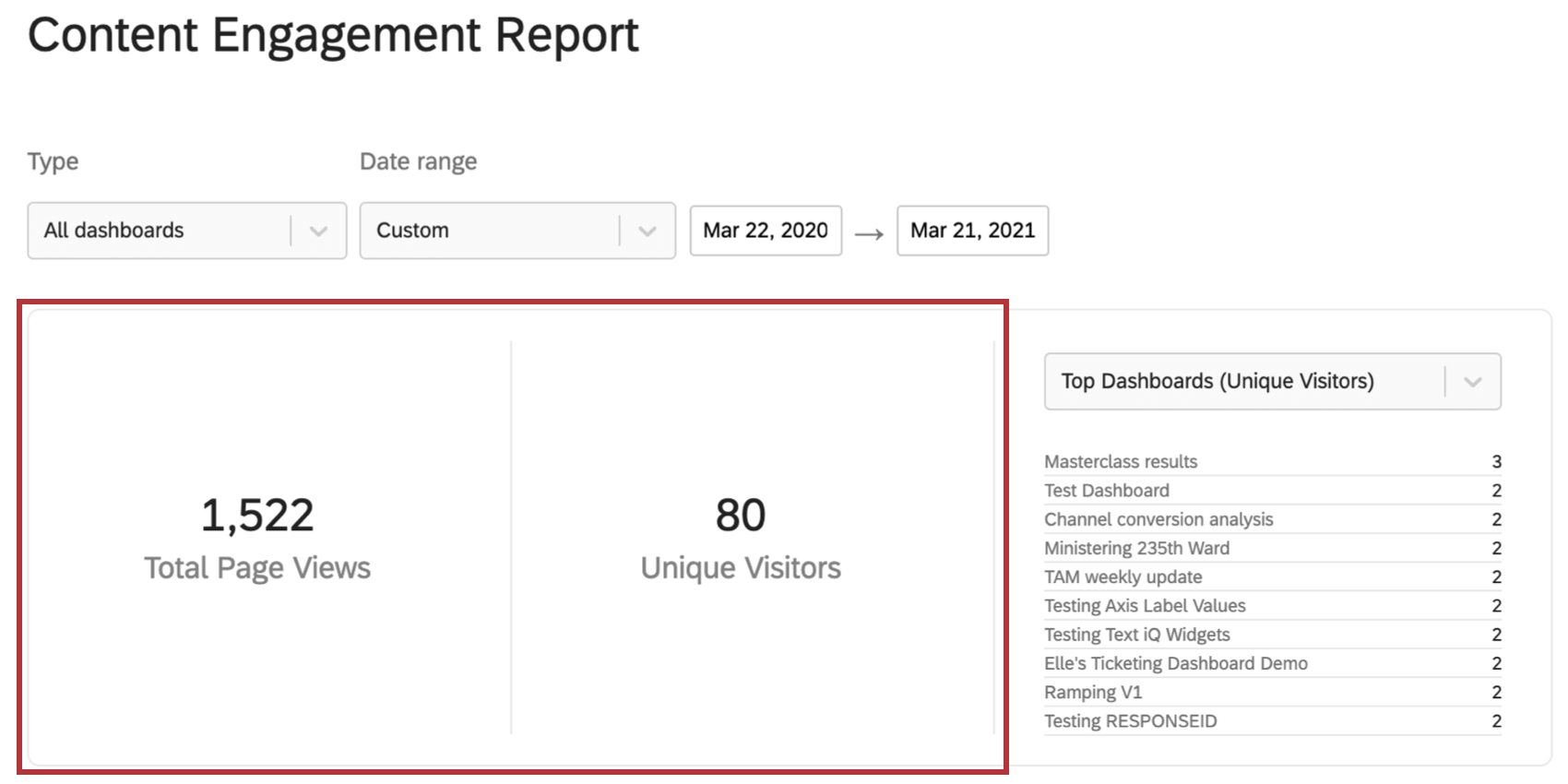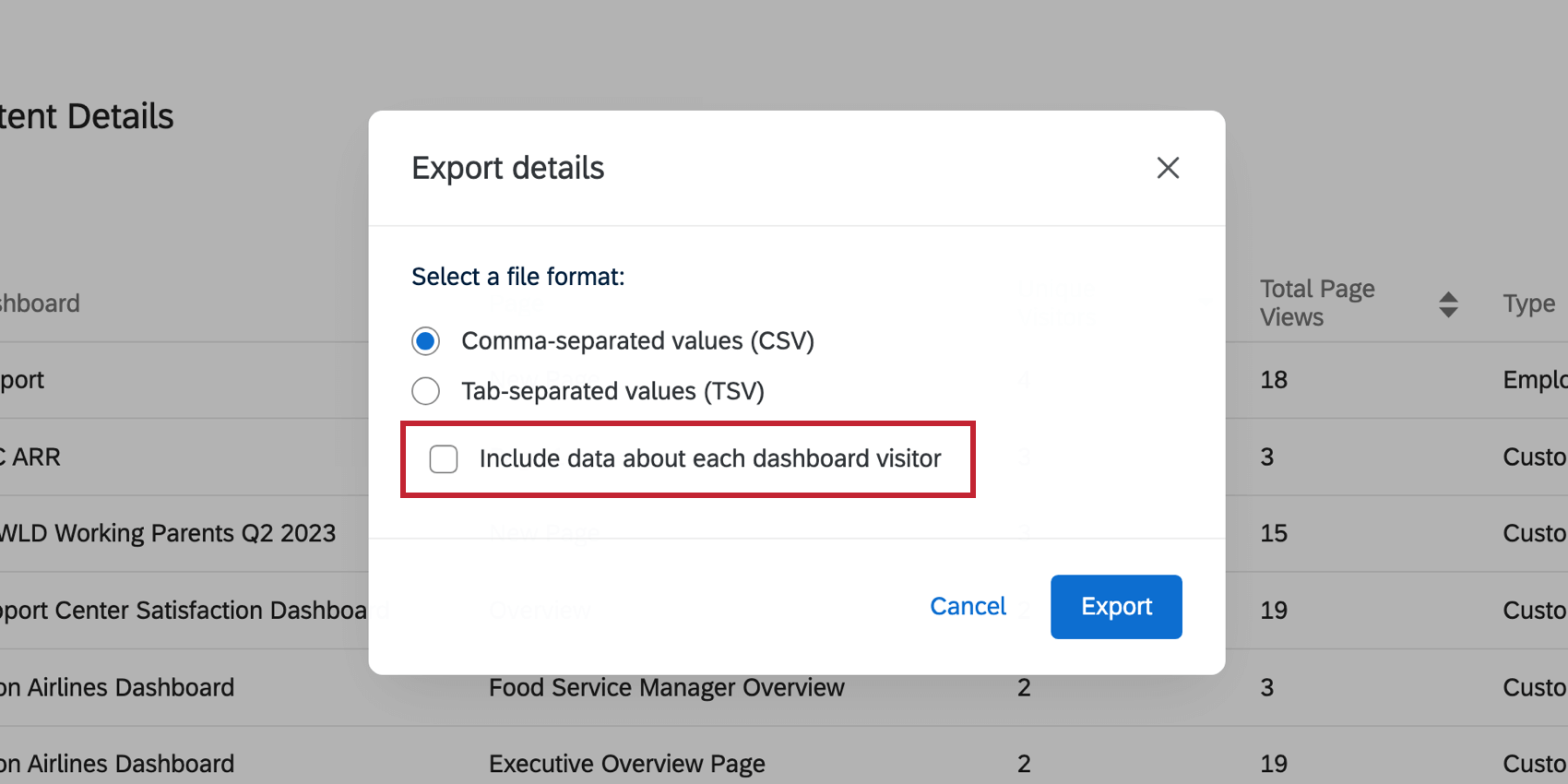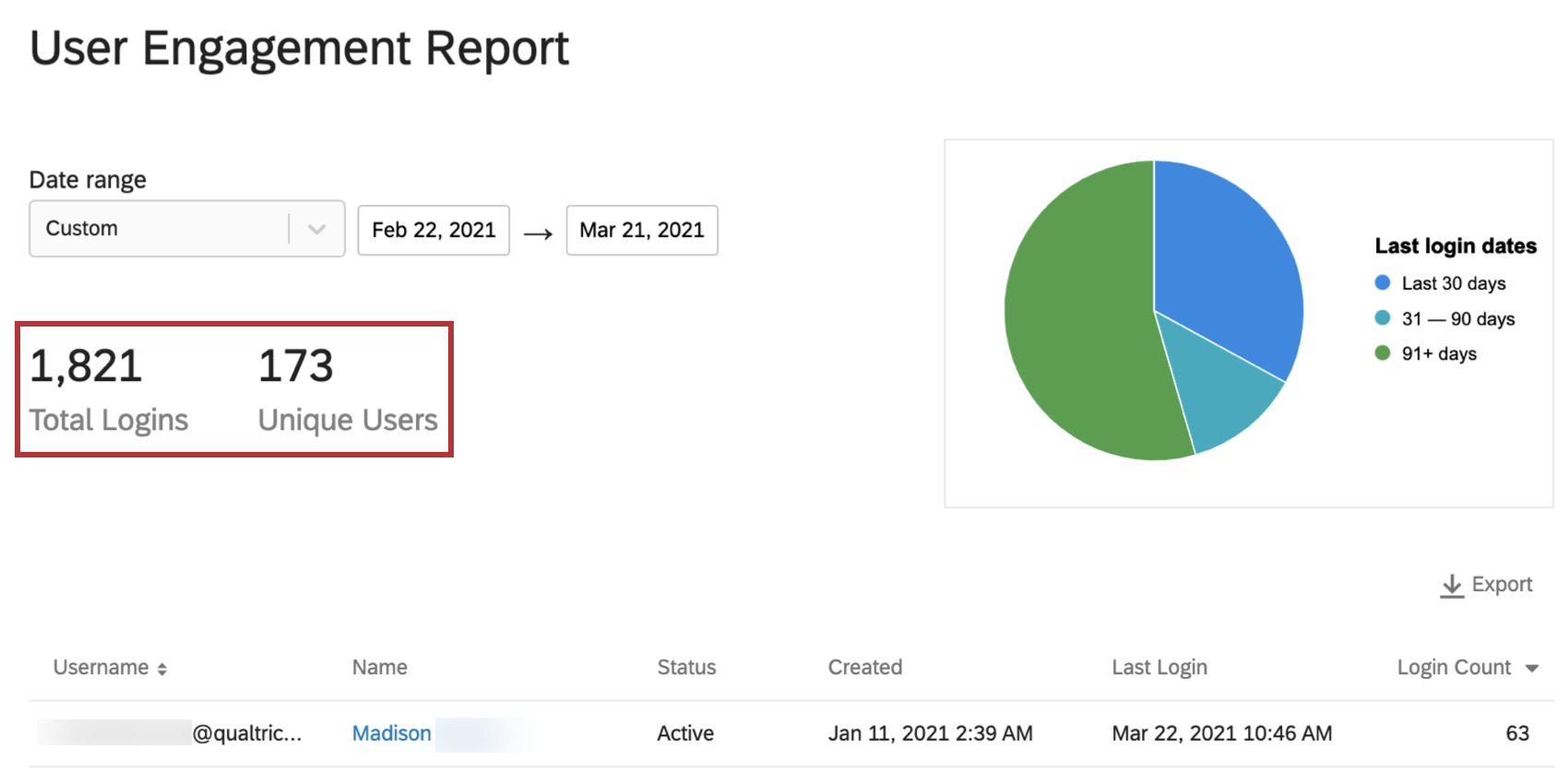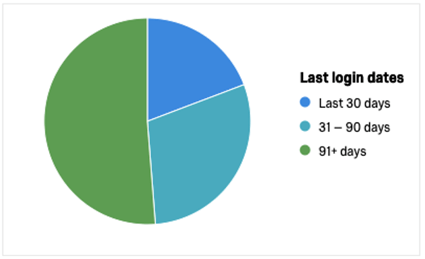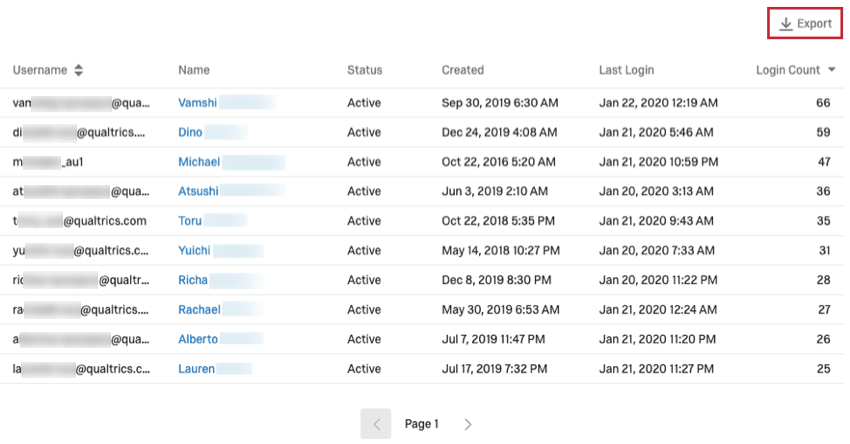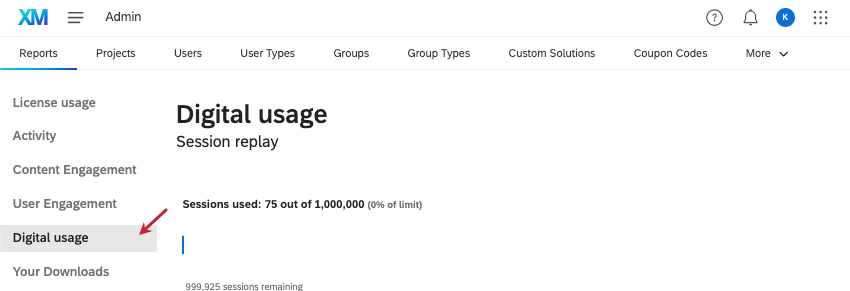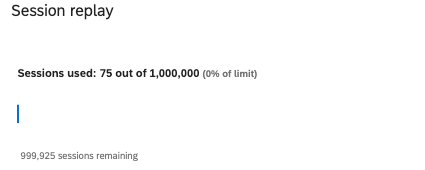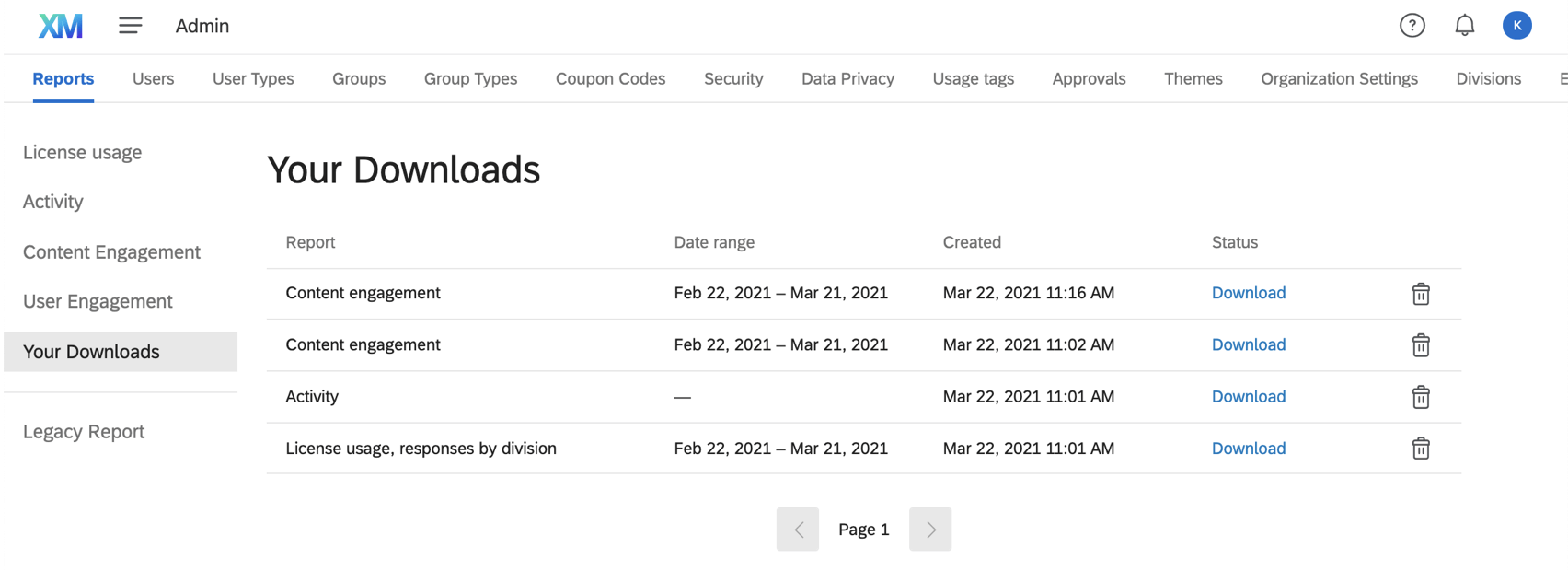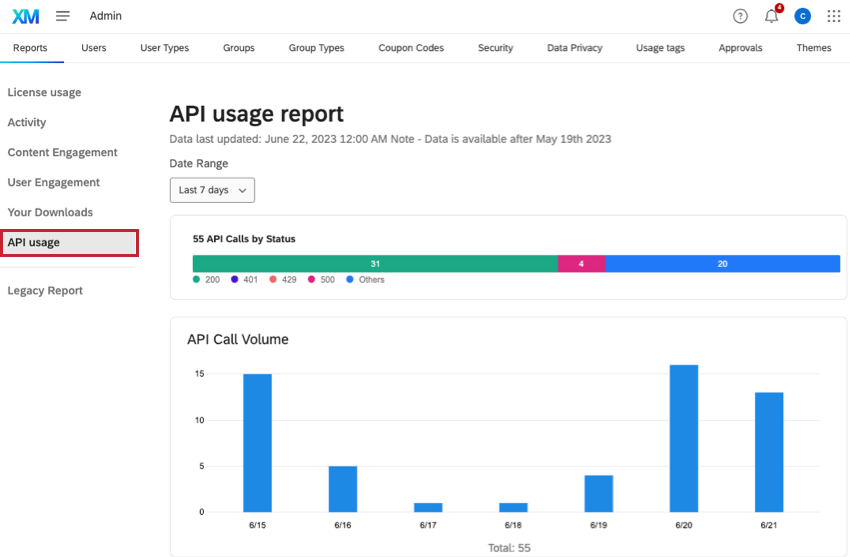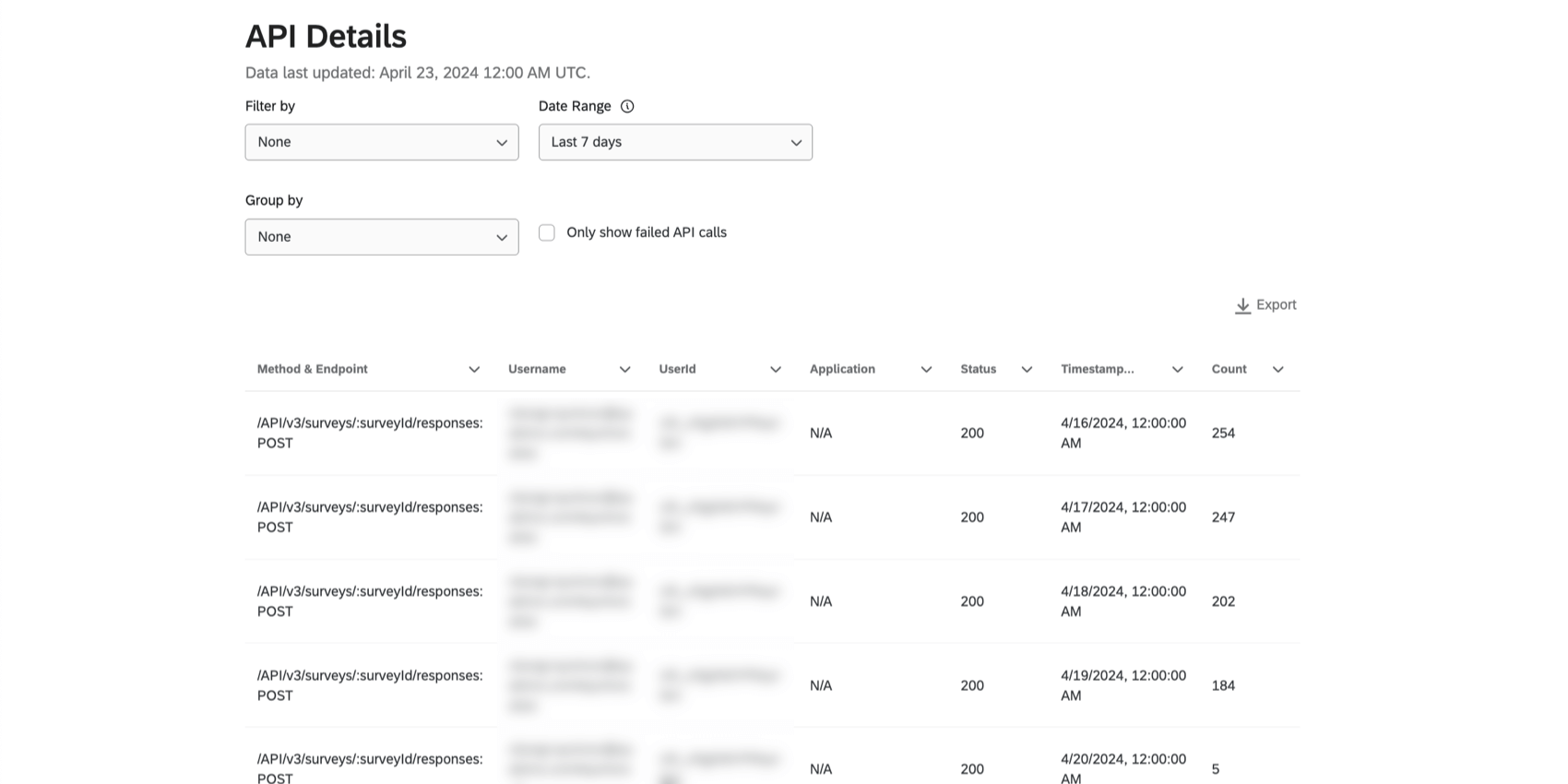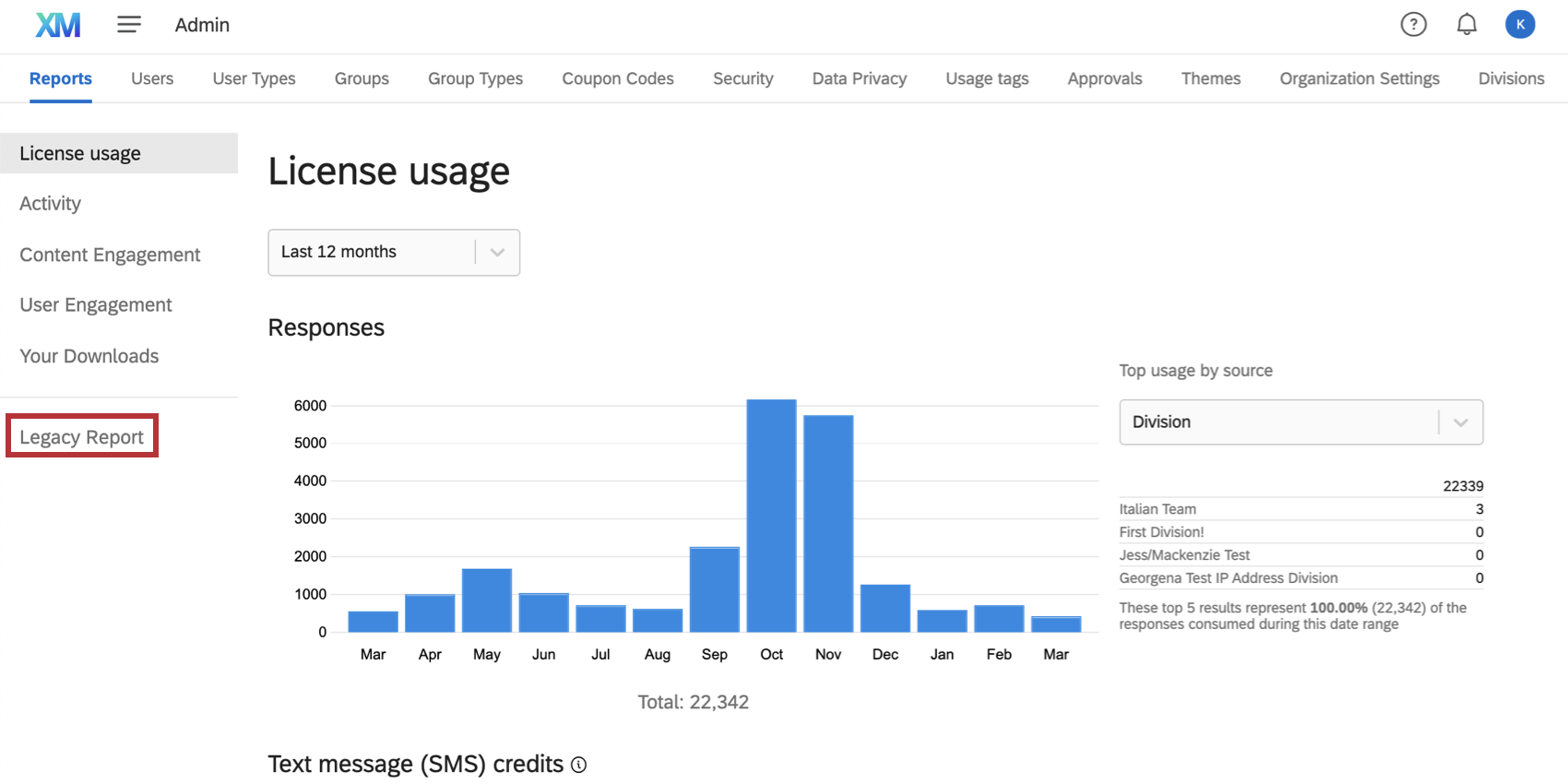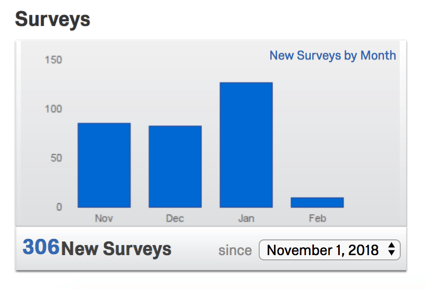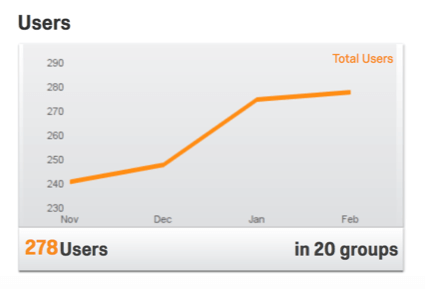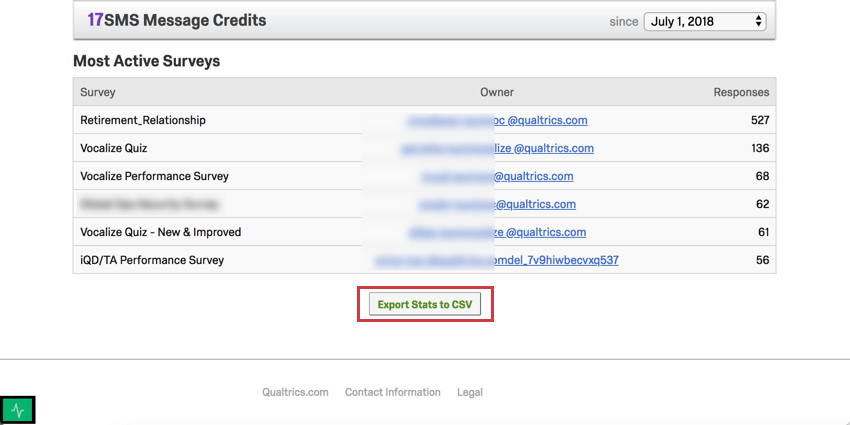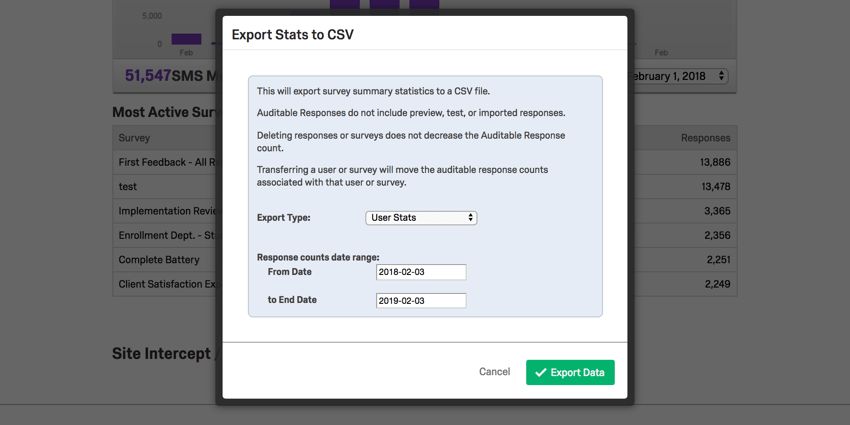Admin Reports
About the Admin Reports
Admin Reports are the best place to answer questions such as who is using how much of your license, who are your most engaged and least engaged users, and what is the quality of research happening in your company as measured by Expert Review. These metrics and more are illuminated in the Admin dashboard, consisting of the Interaction Usage Report, License Usage Report, the Activity Report, the Content Engagement Report, and the User Engagement Report. You can also use this tab to view your brand’s self-enrollment code.
Interaction Usage Report
The Interaction Usage report shows you the interaction consumption for your current Qualtrics license. This is a detailed view of your data consumption allowing for greater transparency into your license usage. Interactions can be survey responses, online reviews, video screen captures, and more.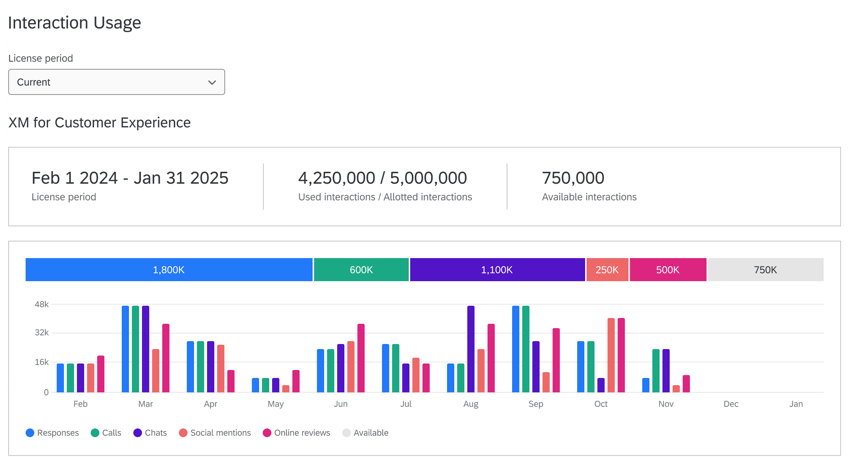
This report shows you the following about your license:
- The current license period
- The number of allotted interactions
- The number of interactions used
- The number of remaining interactions
These metrics are also represented in 2 charts, showing the proportion of how many interactions you’ve used overall and the interaction breakdown by each month.
Usage Details
You can view more granular information about each type of interaction in the Usage Details section.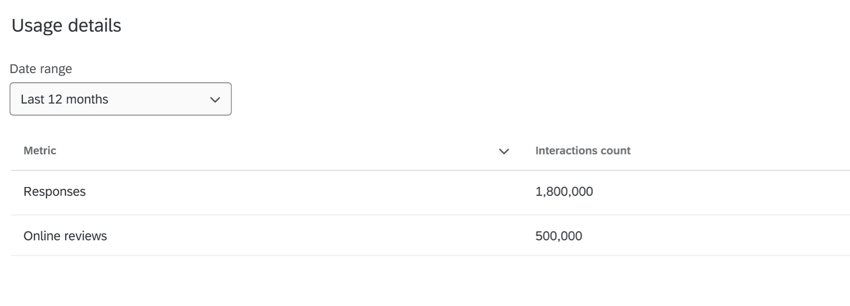
This table shows each type of interaction available for your license and how many of each type have been used over the chosen time period. You can use the Date range dropdown to choose a predefined time period, or select a custom one.
The following interactions will appear in this table:
- Moderated Response: Responses to moderated user testing.
- Online Reviews: Reviews in an Online Reputation Management project (as of October 14, 2024).
- Responses: Responses to surveys (as of May 1, 2024).
Qtip: Responses to EX surveys are not included.
- Unmoderated Responses: Responses to unmoderated user testing questions.
- Video Minutes: Responses imported into an imported audio & video project and screen captures for video response questions (as of July 18, 2024).
License Usage Report
The License Usage Report allows you to view how many responses, SMS credits, and user seats have been used by your license within a given time period. You can also export this data. If you’ve set up Usage Tags as a cost management system, you can break out your data by the tags as well.
At the top of all of these reports, you can filter by the time period you’d like to see license usage for.
Billable Responses Chart
The Billable responses chart displays how many responses have been collected by the surveys in your license.

SMS Credits Chart
The SMS Credits chart displays how many SMS credits have been consumed in your brand, as well as the remaining SMS credits for the brand.

New Users Chart
The New Users chart displays how many new user accounts have been created in your license. Use the dropdown menu to the right of the chart to change what the chart displays. You can break out your data by division or any tags you’ve created.
Usage Details Table
The Usage Details table displays the same information as the charts in your License Usage Report, but in a different format. You can also export the data from this section. The Usage Details table is located at the bottom of the License Usage Report page.
- Use the Report on dropdown to choose what is being reported. You can choose to report on Responses, SMS credits, or Users.
- Use the Group by dropdown menu to break out the data. You can group by Division, User, any tags you’ve created, or choose not to group your data.
- The Date range dropdown menu is used to choose the time frame of the data you want to include in your report. If you are reporting on Users, then this date range will show you users created within that time frame.
- Click the Export button to download a CSV or TSV version of the table.
The Billable responses column shows you total billable responses for your chosen group. The data will also further be broken out by license type (i.e., CX, BX), so that if you have access to multiple products, you can see where the responses were used. “CoreXM” refers to use of survey projects and other core platform features not included in CX, BX, or PX. If you ever have questions about billable responses, talk to your account team.
Qtip: You can export details about all users in your brand by setting filters to:
Report on: Users
Group by: None
Date range: All
Activity Report
The Activity report shows the survey activity within your brand. Here, you can see details of all surveys in your brand including their quality as measured by Expert Review.
Active, Pending, and Inactive Surveys
The first graph in the Activity Report provides the total number of surveys in the brand (center of circle). The colors on this pie chart represent how many of these surveys are active, pending review, or inactive. Highlight over a colorful section of the chart to get the exact number of surveys in the brand that have that status.
- Active Surveys: Surveys that can collect survey responses. These surveys are not new, paused, or closed.
- Pending Review: If you have designated that users must have surveys approved before they go live, this status will show how many surveys have been submitted for approval but are not approved and activated yet. Learn more about the permissions needed to set up this process on the Survey Approval Process support page.
- Inactive Surveys: These surveys have been paused or closed.
You can click statuses in the legend to exclude them from the graph, or to reinclude them.
ExpertReview
The ExpertReview breakdown bar helps you check the quality of your brand’s surveys by displaying the scores of surveys that have ExpertReview enabled. You can highlight over the bars of this graph to get the survey count.
To learn more about ExpertReview and how it scores surveys, see the linked support page.
Survey Details
The Survey Details table provides insight into when surveys were created, how many responses they’ve collected, their status, their ExpertReview rating, and whether they contain sensitive data in the questions or responses.
You can filter activity reports by survey creation date range and response date range by using the drop-downs above the table.
The Survey Details report the presence of sensitive data as a Yes or No. To learn more about the specific topics being violated, reach out to the survey owner.
| Yes | No | N/A | |
| Sensitive Data in Questions | Survey contains questions that ask for sensitive data. | Survey does not contain questions that ask for sensitive data. | Sensitive Data evaluation not available for this survey. Surveys created before you turned on Sensitive Data Policy for your brand will have N/A for both columns. |
| Sensitive Data in Responses | Survey responses contain sensitive data. | None of the responses contain sensitive data. | Sensitive Data evaluation not available for this survey. Surveys created before you turned on Sensitive Data Policy for your brand will have N/A for both columns. |
You can click Export to export a CSV or TSV of your Survey Details table. The columns include survey ID, survey name, when it was created, the owner ID, division ID, division name, survey status, responses, owner username, owner user type ID, owner user type name, ExpertReview score, Sensitive Data in Questions, and Sensitive Data in Responses. This export includes every survey in the brand, including deleted ones.
Content Engagement
The Content Engagement report is a great way to determine the dashboards your users engage with the most. Here, you can determine top dashboards by timeframe and export data on pageviews and unique visitors.
Type of Dashboards
You can choose to view all dashboards in your brand, or specify based on whether they are CX, EX, or BX. Depending on your license and what kinds of projects you have access to, not all of these options may be available.
Date Filter
Use the date dropdown to adjust the data displayed on the Content Engagement report. You can choose a preset date, or filter by a custom timeframe. This date filter will adjust all the data in this admin report.
Total Views and Unique Visitors Across Dashboards
To the left of the report are Total Pageviews and Unique Visitors across all dashboards existing in your brand (for the selected timeframe).
- Total Pageviews: Number of individual pageviews. Navigating between pages of a dashboard will increase the pageviews. This metric is generally a higher number than unique visitors, because individuals can visit multiple pages or the same page multiple times.
- Unique Visitors: Individual users in your Qualtrics brand who have viewed the dashboard in the selected timeframe.
Top Dashboards by Total Views or Unique Visitors
Using the dropdown above the list, you can see the top 10 dashboards in your brand.
- Total Views: See the dashboards that have gained the most pageviews within the chosen timeframe. The exact number of views across all pages of a dashboard will be given for each dashboard.
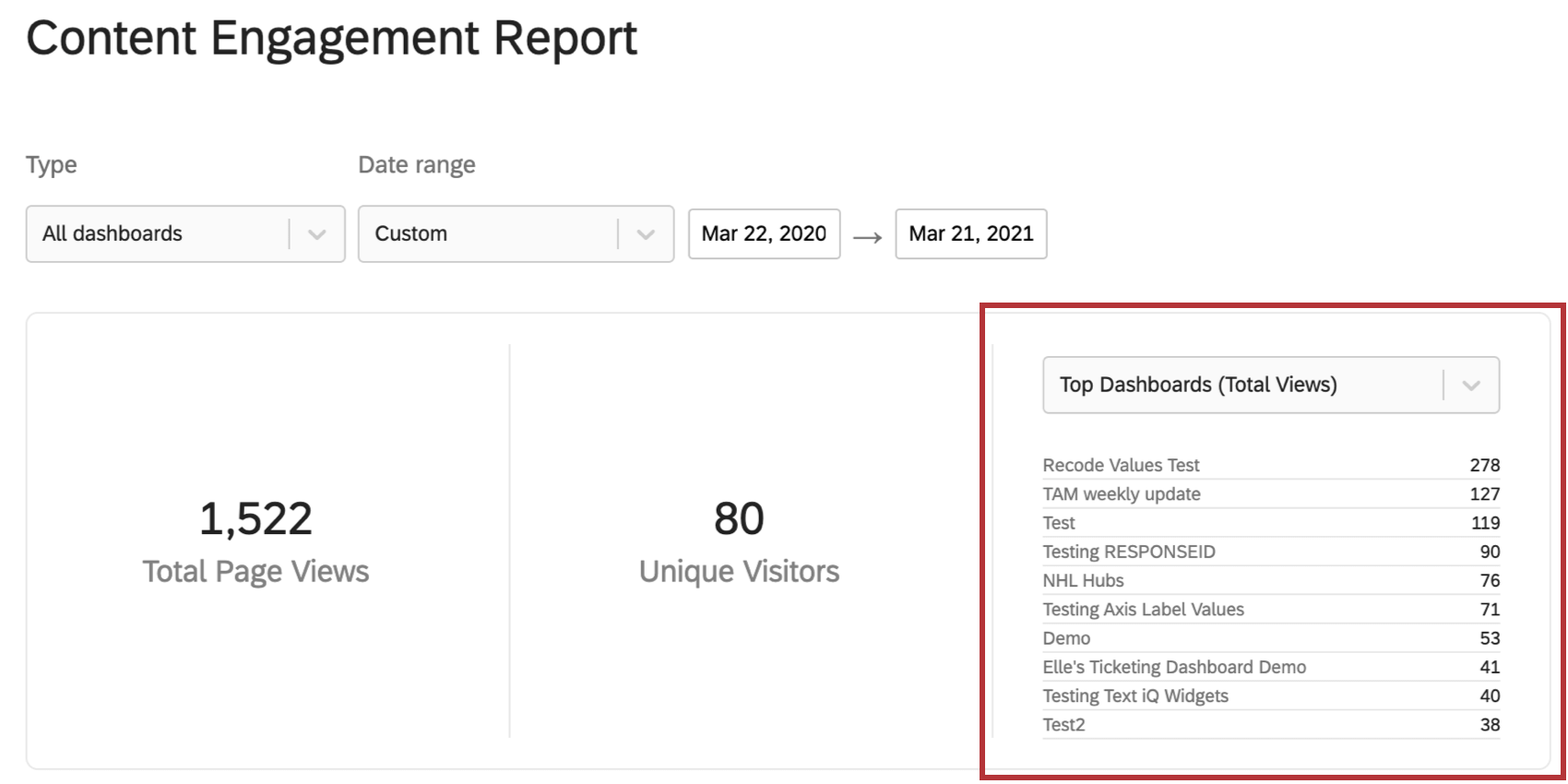
- Unique Visitors: See the dashboards that have been viewed by the most Qualtrics users within the chosen timeframe. The exact number of unique visitors will be given for each dashboard.
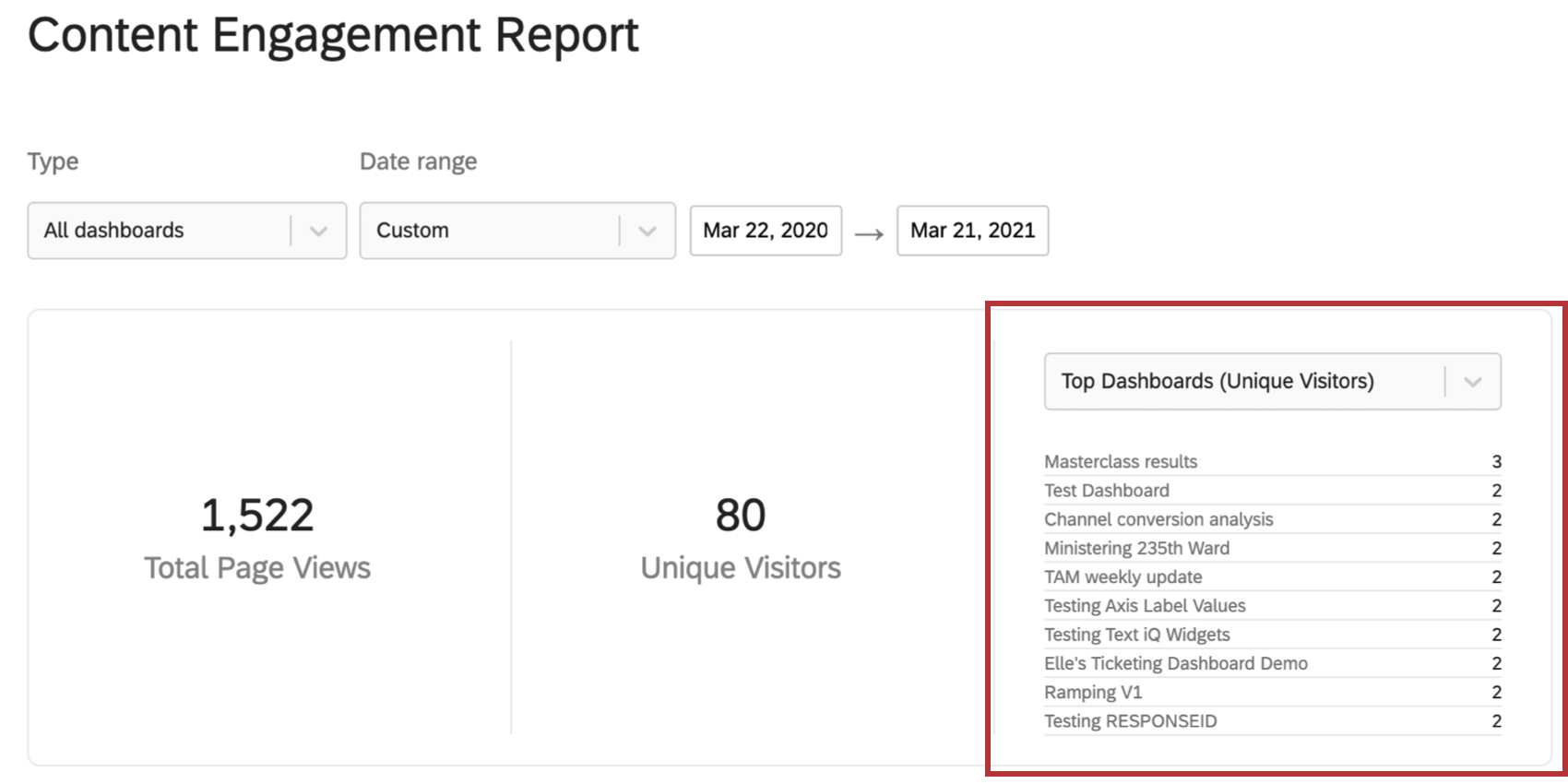
Content Details
The Content Details show unique visitors and pageviews to specific pages of dashboards in your brand (instead of providing this information for the entire dashboard). You can sort the table by pageviews or visitors.
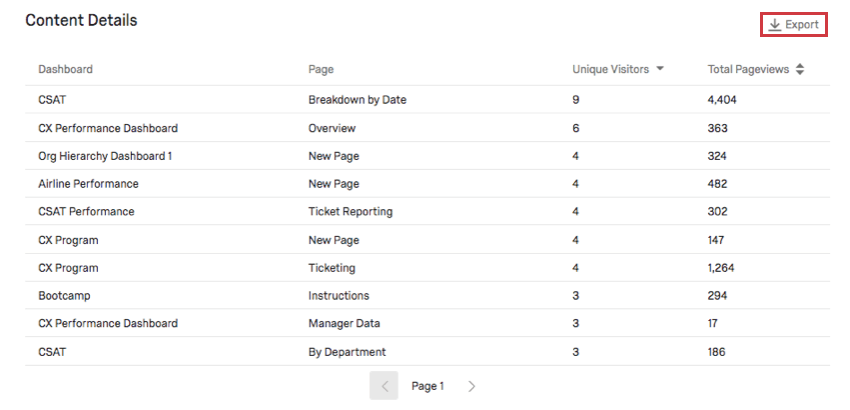
You can download this data to a CSV or TSV by clicking Export. The export includes the Dashboard ID (an internal ID assigned by Qualtrics), the Dashboard’s name, the Page ID (an internal ID assigned by Qualtrics), the page name, total unique visitors, and total pageviews. Each row represents the data for a different dashboard page.
To export a list of users that accessed the dashboard, enable Include data about each dashboard visitor in the export details.
User Engagement
The User Engagement report is a great way to determine which users are most engaged with your Qualtrics license. Here, you will see information on top users and login behavior.
Date Filter
Use the date dropdown to adjust the data displayed on the User Engagement report. You can choose a preset date, or filter by a custom timeframe. This date filter will adjust login and user summary, as well as the data table in this admin report.
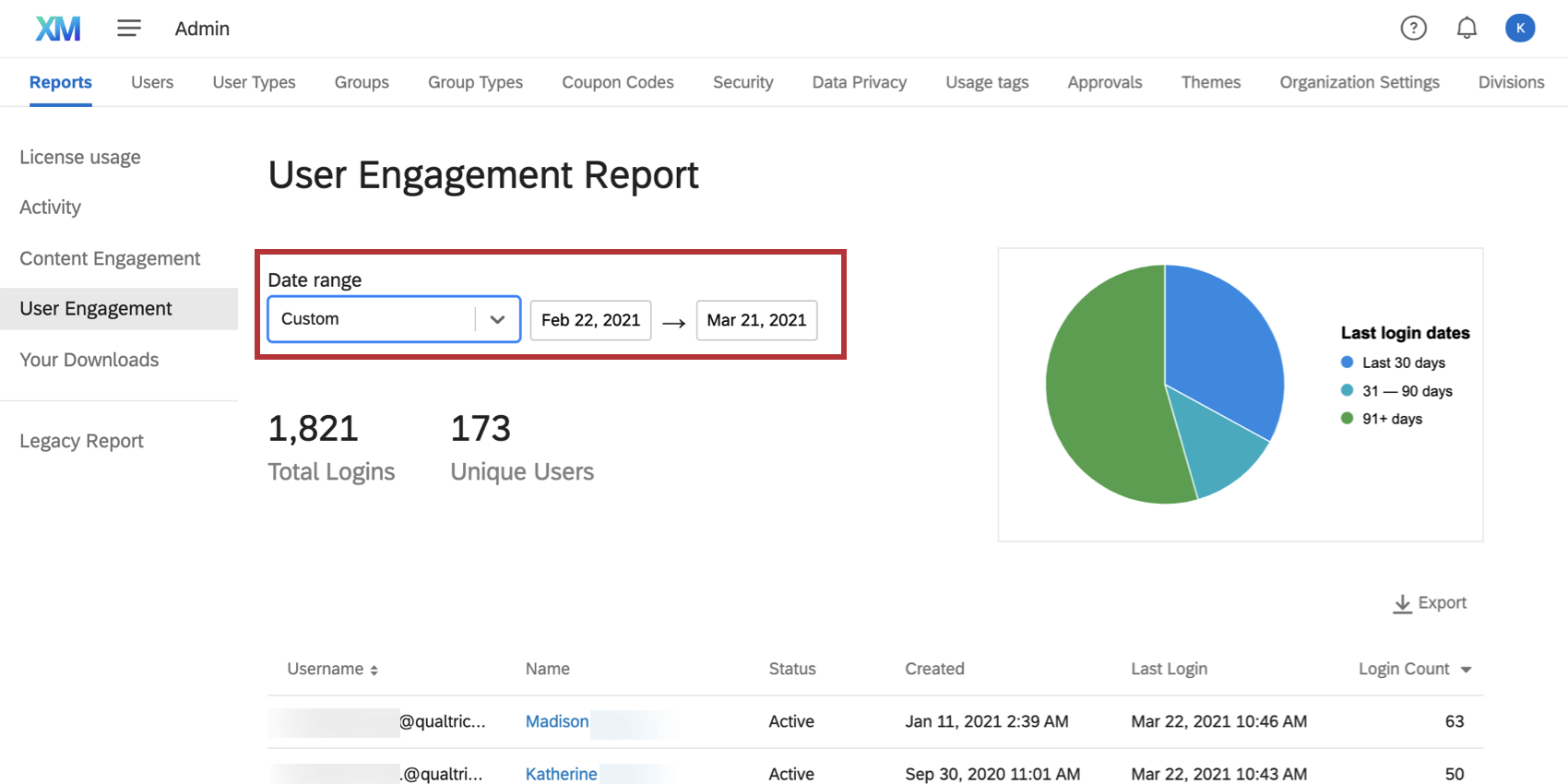
Logins
- Total Logins: The number of times users logged into accounts. This includes the same user logging in multiple times, logins to dashboards (both CX and EX), or Brand Administrators proxy-logging into accounts from the Admin page.
- Unique Users: The number of unique users that logged in.
User Details
This pie charts shows a breakdown of users who logged in:
- Within the last 30 days (blue)
- 31-90 days ago (teal)
- More than 90 days ago (green)
Hover over a color to get an exact count of users who fit into that category.
Exporting User Details
This table shows the usernames, names (which link to the user’s email address), account status, date of account creation, date of last login, and the login count for the filtered users. This table can be sorted by username or login count.
If you export this data, the file will include the user ID (an internal ID assigned by Qualtrics), username, first name, last name, email, account status, when the account was created, when the user last logged in, and how many times they logged in. Like all the data on this report, the export will also match the date filter.
This data can be exported in CSV or TSV format.
Digital Usage
The Digital Usage report tracks your usage of Digital Experience Analytics (DXA). Using this report, you can see session replay usage, then break out that data by month or project.
You’ll have access to this report if your organization has Digital Experience. However, this report only displays Digital Experience Analytics data.
Digital Usage reports update hourly.
Session Replay
Session replay is a feature that tracks your visitors’ website sessions and gives you insight on any frustration behaviors they may display. The Session Replay report shows how many session replay recordings are available to your license, as well as how many have been used, and how many are left over. The number of sessions used is presented as an exact number, a percentage of your total allowance, and as a bar chart.
Session Usage Details
The Session Usage Details shows how many sessions have been recorded in your license each month.
This report also comes with filters you can adjust:
- Project filter: Use the first dropdown to filter for a specific Website & App Insights project with Session Replay enabled. Select “All” to see session usage across all eligible projects.
- Date filter: Choose how many months of data you want to see in the graph.
Exporting Session Usage Details
The filters you apply to the Session Usage Details graph also apply to the table below. This table includes information on each project recording sessions, including:
- The name of the project.
- The status of the project.
- How many sessions this project used in the timeframe you chose.
Click Export to download this data as a CSV or TSV file.
Your Downloads
In the Your Downloads section, you can view any files you’ve downloaded from the admin reports. Files will appear here for 30 days.
A list of reports is shown on this page with the report it was downloaded from (e.g., license usage or activity), the dates it was filtered for, the date you requested to download the file, the status, and the ability to delete the file from your download history. Time zones match the one set in your account.
To re-download a file, click Download.
API Usage
In the API Usage section, you can see a count of all API calls made by your brand. You can also see the status of API calls, as well as API call volume over time. Only data for the last 60 days will be displayed.
You can also view the API Details table for more info on API calls. This includes the Method & Endpoint, UserID, and Status. For more information on the Qualtrics API, see the API Reference.
The Application column will tell you if there’s a workflow in Qualtrics where this specific API was run. If you see “N/A,” this likely means the API was run outside of workflows.
Exporting API Usage Details
You can export the data from the API Details table to CSV or TSV. You can also filter results and choose how they’re grouped in the exported file.
- If you want, filter the results shown in the table. You can select an exact match, or type an approximate search. The categories you can filter by include:
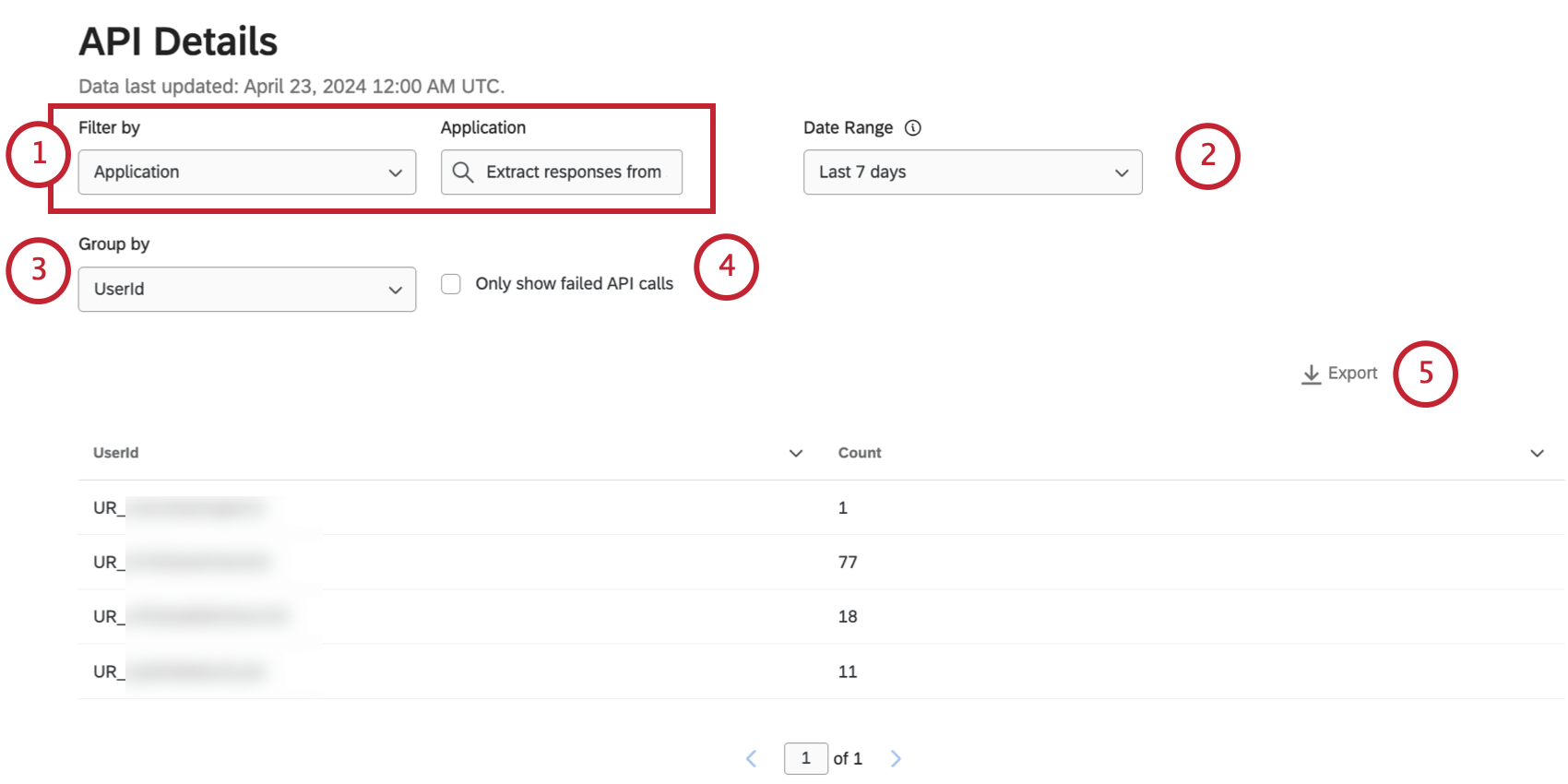
- Method & Endpoint
Qtip: Filter API Details by Method & Endpoint if there’s a specific API call you’re interested in.
- Username
- UserId
- Application
- Status
Qtip: You can only filter by 1 category set to 1 value at a time. For example, if you’re filtering by someone’s UserId, you cannot filter for an additional user or add a Status filter on top.
- Method & Endpoint
- Choose your date range.
Qtip: API Usage Details only displays 90 days worth of API call history.
- Instead of seeing detailed information on each call performed in your organization, you can instead group results. Grouping results shows you the number of API calls for each category you choose.
Example: Group by username to see how many API calls each user made. Only users who have made API calls in your selected date range are included in the list.
- If you only want data on API failures, select Only show failed API calls. If this is unchecked, you’ll see information on both successful and failed API calls.
- Click Export.
- Choose your file format:
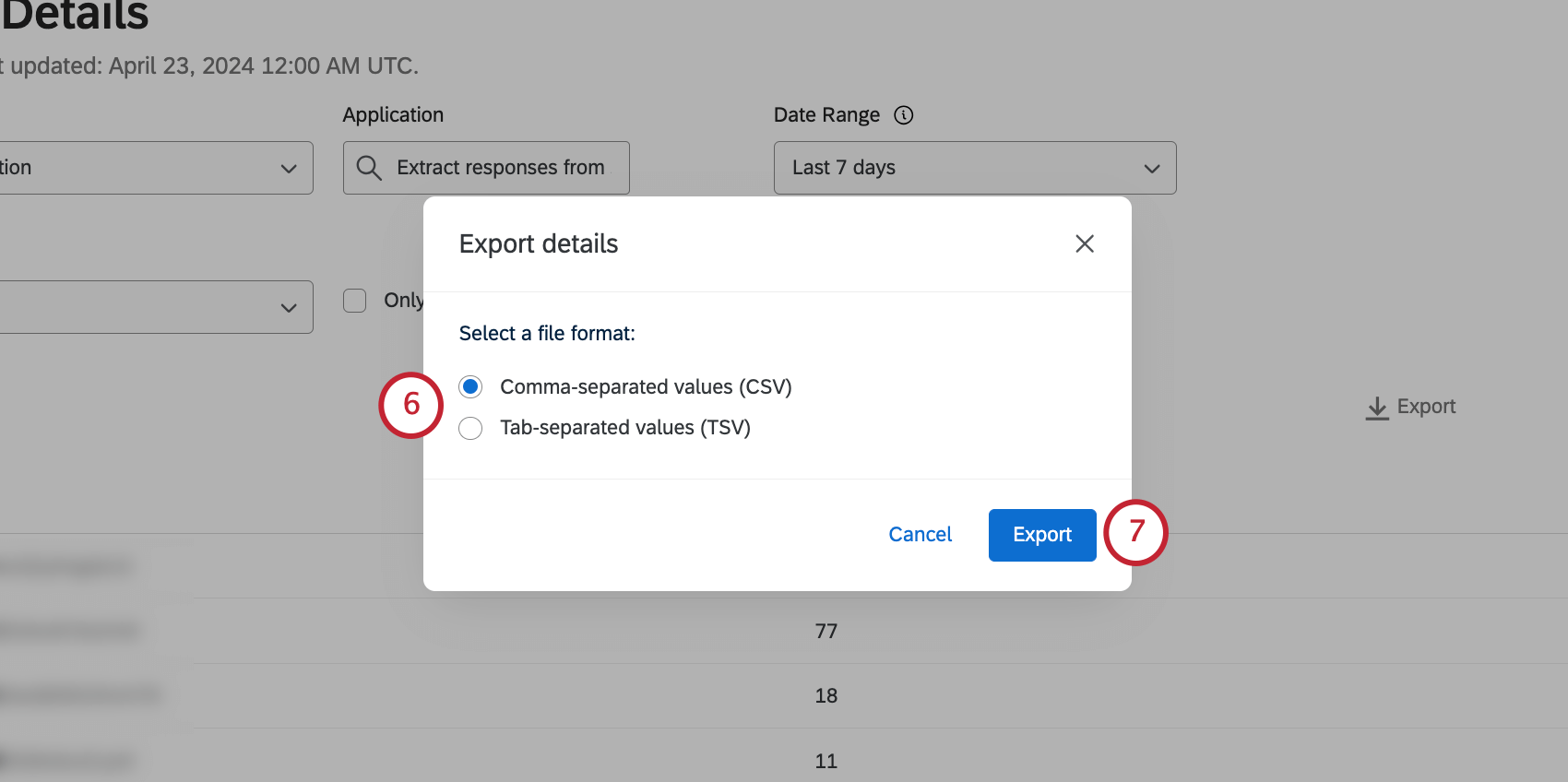
- CSV (comma-separated values)
- TSV (tab-separated values)
- Click Export.
- When your file is ready, click Download.
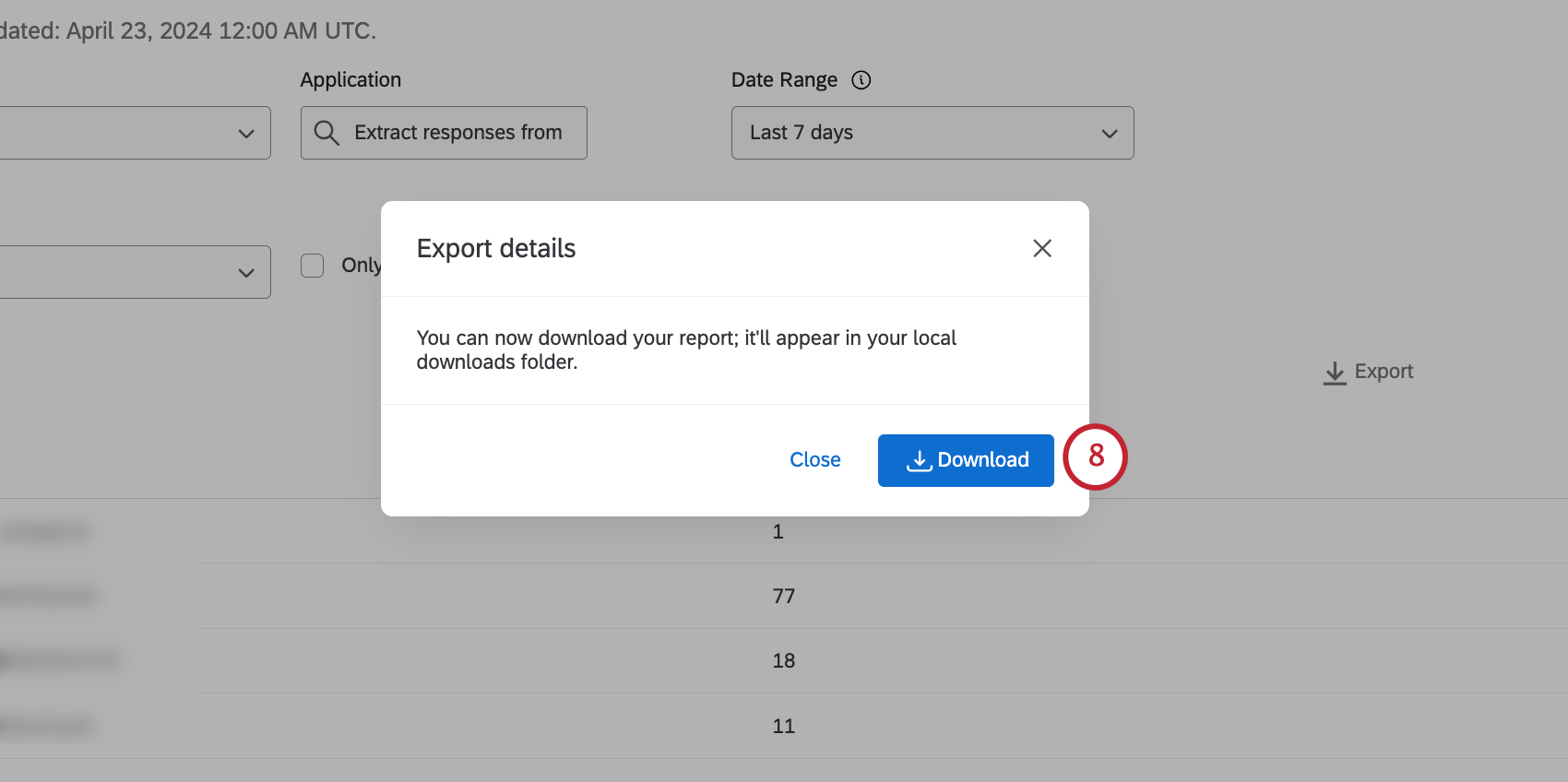
Self-Enrollment Code
The Self-Enrollment Code serves as an extra security measure. For example, if you don’t want to restrict the email domains people can use to sign up with your Qualtrics license, you can choose a Self-Enrollment Code instead. This functions as a code new users have to enter when signing up to complete the account.
The Self-Enrollment Code is randomly generated and displayed at the top of your Admin Report as soon as the permission is turned on for your organization.
Auditable Responses
This section tracks the number of responses collected in your license. This includes any responses collected on the Recorded Responses page, except Preview Data, Test Data, and Imported Responses.
Surveys
This sections counts all the surveys on the license that have a status of new.
Users
SMS Message Credits
If your license has purchased access to SMS distribution, this section will show you how much of your available credit you’ve used.
Most Active Surveys
This section is a list of surveys sorted from most to least responses received. The survey name and owner will be displayed.
Export Stats to CSV
In addition to these metrics, you have the option to export a detailed spreadsheet of the usage statistics for your organization. This export option is found at the bottom of the page.
When you export these stats, you will have the option to specify a date range and the type of data you’d like to export.
- User Stats: Statistics for every user in the brand. Includes a column for User ID, username, email, first and last name, the date the user was created, the date their account expires (if such a date was applied), the last time they logged in, user type, user status (enabled, disabled, or not verified), division, number of surveys, auditable responses collected, and “other responses” (previews, tests, etc., which are not auditable).
- Survey Stats: Statistics for every survey in the brand. Includes a column for Survey ID, survey name, survey description (meta description), auditable responses collected in that survey, “other responses” collected in that survey (previews, tests, etc.), survey status, creation date, Owner ID, username of the survey’s owner, first and last name of the survey’s owner, their user type, and their division. Before you export the data, you can choose from a list of columns to sort the data by.
- Survey Stats, Grouped: Export data on auditable vs. “other” (non-auditable) responses. This data can be presented by user (first name, last name, username, or Owner ID), by survey (survey name or Survey ID), or by division.
